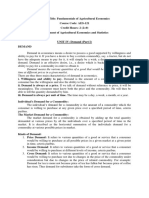0 ratings0% found this document useful (0 votes)
61 viewsDemand and Supply
Demand is defined as the willingness and ability to buy a product. The law of demand states that price and quantity demanded are inversely related - if price increases, quantity demanded decreases, and vice versa. The demand curve slopes downward to show this. Non-price factors like income, tastes, and prices of substitutes and complements can cause the demand curve to shift. Supply is defined as the willingness and ability to sell a product. The law of supply states that price and quantity supplied are directly related - if price increases, quantity supplied increases as well. The supply curve slopes upward. Non-price factors like input costs, weather, taxes, and subsidies can cause the supply curve to shift.
Uploaded by
Maham UmairCopyright
© © All Rights Reserved
Available Formats
Download as PPTX, PDF, TXT or read online on Scribd
0 ratings0% found this document useful (0 votes)
61 viewsDemand and Supply
Demand is defined as the willingness and ability to buy a product. The law of demand states that price and quantity demanded are inversely related - if price increases, quantity demanded decreases, and vice versa. The demand curve slopes downward to show this. Non-price factors like income, tastes, and prices of substitutes and complements can cause the demand curve to shift. Supply is defined as the willingness and ability to sell a product. The law of supply states that price and quantity supplied are directly related - if price increases, quantity supplied increases as well. The supply curve slopes upward. Non-price factors like input costs, weather, taxes, and subsidies can cause the supply curve to shift.
Uploaded by
Maham UmairCopyright
© © All Rights Reserved
Available Formats
Download as PPTX, PDF, TXT or read online on Scribd
You are on page 1/ 41
What is demand?
Demand is defined as the willingness and ability to by a product.
In economics, when we discuss demand for a product, we are
discussing effective demand which has two essential components:
• Willingness to buy
• Ability to buy
An individual may want to buy a product but if they cannot afford to
buy it, their demand is not effective as a firm will not be prepared to
sell it to them.
The law of demand:
The price of a product and its quantity demanded are inversely related,
ceteris paribus. This means that if the price of a product increases, the
quantity demanded decreases; on the other hand, when the price of a
product falls, the quantity demanded increases.
Ceteris paribus: holding all other factors constant
A change in
price leads to
a change in
quantity
demanded
and is shown
my a
movement
along the
demand
curve.
The demand curve is downward sloping
because price and quantity demanded are
inversely related.
The demand schedule is used to draw a demand curve:
Lets practice drawing a demand curve!
Individual Vs. Market demand:
Individual demand is the amount of a product an individual would be
able and willing to buy at different prices.
Market demand refers to the total demand for a product at different
prices. It is found by adding up, or aggregating, each individual's
demand at different prices.
Individual Demand Market Demand
Effect of a change in price on demand
• Extension in demand (expansion of demand): a rise in quantity
demanded as a result of a fall in price.
• Contraction of demand: a fall in quantity demanded as a result of a
rise in price.
Exercise:
A shop changes the price of a can of soft drink from $3 to $2 and, as a
result, demand changes from 40 cans a day to 50 cans.
a) Illustrate this change on a demand curve.
b) Identify whether demand has extended or contracted.
Non-price factors that change demand (Conditions or
Determinants of demand):
There are a variety of non- price factors that may cause a change in
demand – either more or less of a product being demanded – even if
price is unchanged. These are sometimes known as ‘conditions of
demand’. E.g. weather or season has an effect on demand for ice cream
so in hot weather there is an increase in demand for ice cream at each
and every price.
Changes in these non-price factors will result in a shift in the demand
curve.
Shift due to changes in demand:
Some non-price factors that cause changes in
demand are:
• Changes in income: An increase in a person’s income will increase D for
normal goods and decrease D for inferior goods.
• Changes in the price of substitutes: A substitute is a good that may be used in
place of another. E.g. tea & coffee. An increase in price of a substitute e.g. tea
will increase demand for coffee, while a decrease in the price of tea will
increase D for coffee.
• Changes in the price of compliments: A complimentary good is one that is
used together with another product. E.g. printer and ink cartridges, tea and
tea whitener. An increase in the price of ink cartridges will decrease the D for
printers while a decrease in price of cartridges will increase D for printers.
• Advertising campaigns: effective advertising campaigns will increase the
demand for the product advertised.
• Changes in age structure of population: for a product such as toys, demand will
fall is the population is aging (% of elderly increases)
• Changes in tastes and fashion: a product’s demand will increase if it is in fashion
or becomes more popular while if a product goes out of fashion, its demand
falls.
• Expectation of future prices: if price of a product is expected to rise in the
future, people will demand more of it today
Effect of a increase in income:
Normal good Inferior good
Effect of a change in the price of a substitute:
Increase in price Decrease in price
Effect of change in the price of a complimentary
good:
Increase in price Decrease in price
Effect of an Advertising Campaign:
Effect of a change in age structure of
population:
• E.g. when the population is aging (percentage of elderly increases)
Effect of a change in tastes/fashion:
• E.g.
Practice questions:
Draw demand diagrams for the following and write a brief explanation
as well:
a) Effect on demand for cell phone if consumer income increases.
b) Effect on demand for butter if margarine becomes cheaper.
c) Effect on demand for playstation if price of game CDs decreases.
d) Effect on demand for sugar if its price if expected to rise in the
future.
e) Effect on demand for apples if their price increases.
Supply:
• Supply is the willingness and ability to sell a product.
• Relationship between supply and price:
There is a direct relationship between price and quantity supplied, ceteris paribus.
The higher the price, the greater quantity supplied and vice versa.
Explanation: when the price of a commodity increases, there is an opportunity to
make more profit so producers are willing to sell more so quantity supplied
increases.
Supply curve:
Effect of change in price:
• Extension of supply: an increase in quantity supplied a result of an
increase in price
• Contraction of supply: a decrease in quantity supplied as a result of a
decrease in price
Non-price factors that change supply:
• Factors other than price that may change quantity supplied at each
given price
• Also called ‘determinants of supply’
• A change in any of the determinants may result in a shift in the supply
curve
Shifts in supply curve due to change in supply:
Non-price factors/determinants of supply:
Availability of factors of production:
The availability of factors of production, such as labour or raw
materials, can affect the amount that can be produced and supplied.
For example, if a firm producing motor vehicles experiences a shortage
of steel for its body panels, then its ability to produce vehicles will be
reduced.
Cost of inputs/resources
Changes in input costs will alter a firm’s calculation of how much to
supply at a given price. For example, if the same motor manufacturer
experiences an increase in labour costs due to an increase in the wage
rate, the cost of producing each vehicle will rise. This means that the
price the manufacturer expects to receive will increase. If the price
does not increase, less will be produced, ceteris paribus
New firms entering the market
In terms of total supply to a market, the number of firms in the market
will affect the total supply. New firms in a market will increase market
supply and firms leaving will reduce supply. New firms may be attracted
into a market because of the expectation of profits and existing firms
may leave because they cannot cover their costs, and make losses.
Weather and other natural factors:
Changes in the weather can have a considerable impact on the ability
to produce certain products, like farm produce and commodities. This
tends to affect the primary sector more than manufacturing
Taxes on manufacturing:
An increase in the tax rate means businesses have to pay a larger % of
their profits as taxes to the government. This raises their cost of
production and is passed on by firms to customers in the form of
higher prices resulting in a leftward shift of the supply curve.
Subsidies:
Subsidies are funds given to firms to enable them to increase their
supply or to reduce the price of their product to the consumer.
Subsidies can increase the firm’s willingness and ability to produce and
supply.
You might also like
- Development Policymaking and The Roles of Market, State, and Civil Society71% (7)Development Policymaking and The Roles of Market, State, and Civil Society31 pages
- 2.1 - 2.9 - How Markets Work - IGCSE AIDNo ratings yet2.1 - 2.9 - How Markets Work - IGCSE AID15 pages
- Market Forces of Supply and Demand EconomicsNo ratings yetMarket Forces of Supply and Demand Economics5 pages
- Theory of Demand and Supply: Teach A Parrot To Say "Demand and Supply" and You Have An Economist (Campbell R.)No ratings yetTheory of Demand and Supply: Teach A Parrot To Say "Demand and Supply" and You Have An Economist (Campbell R.)17 pages
- Written-Report-Law of Supply and DemandNo ratings yetWritten-Report-Law of Supply and Demand19 pages
- Supply and Demand by Syed Mainur RashidNo ratings yetSupply and Demand by Syed Mainur Rashid52 pages
- 503-Unit-II-Demand and Supply AnalysisNo ratings yet503-Unit-II-Demand and Supply Analysis26 pages
- Business Economics - Unit II - DEMAND SUPPLYNo ratings yetBusiness Economics - Unit II - DEMAND SUPPLY105 pages
- Edexcel (A-Level Year 1 and As) Demand and AD NOTESNo ratings yetEdexcel (A-Level Year 1 and As) Demand and AD NOTES27 pages
- ECO2011 Basic Microeconomics - Lecture 5No ratings yetECO2011 Basic Microeconomics - Lecture 534 pages
- Factors That Influence Demand and SupplyNo ratings yetFactors That Influence Demand and Supply6 pages
- AQA (A-Level Year 1 and AS) Demand and AD NOTESNo ratings yetAQA (A-Level Year 1 and AS) Demand and AD NOTES27 pages
- ECN1101 - Micro Economics: Ms. Farida's ClassNo ratings yetECN1101 - Micro Economics: Ms. Farida's Class25 pages
- The Role of Markets in Allocating Resources: Microeconomics and MacroeconomicsNo ratings yetThe Role of Markets in Allocating Resources: Microeconomics and Macroeconomics13 pages
- Economics Lecture Notes - Chapter 2 - Economics CafeNo ratings yetEconomics Lecture Notes - Chapter 2 - Economics Cafe11 pages
- The Suez Canal and The British Economy: Richard C. WhitingNo ratings yetThe Suez Canal and The British Economy: Richard C. Whiting10 pages
- Employee Benefits Exercises - Pensions and LT BenefitsNo ratings yetEmployee Benefits Exercises - Pensions and LT Benefits3 pages
- Chapter 2 Market Forces-Demand and SupplyNo ratings yetChapter 2 Market Forces-Demand and Supply29 pages
- By Robert E. Hall & Marc Lieberman: Economics: Principles and Applications, 2eNo ratings yetBy Robert E. Hall & Marc Lieberman: Economics: Principles and Applications, 2e17 pages
- International Financial Management 8th Edition Madura Test Bank100% (42)International Financial Management 8th Edition Madura Test Bank40 pages
- Nulpmss - 47.11.34.16110.03.2022 - 2 PM - Bomhc101 - Financial Accounting - 2021No ratings yetNulpmss - 47.11.34.16110.03.2022 - 2 PM - Bomhc101 - Financial Accounting - 20212 pages
- Call +91 9712985389: To Enquire. Whatsapp: 9830110214No ratings yetCall +91 9712985389: To Enquire. Whatsapp: 983011021415 pages
- MGT402 Cost and Management Accounting 2010 Final Term Solved With Ref - 1No ratings yetMGT402 Cost and Management Accounting 2010 Final Term Solved With Ref - 110 pages
- Managerial Economics Field Based Assignment On Coca ColaNo ratings yetManagerial Economics Field Based Assignment On Coca Cola9 pages

























































































